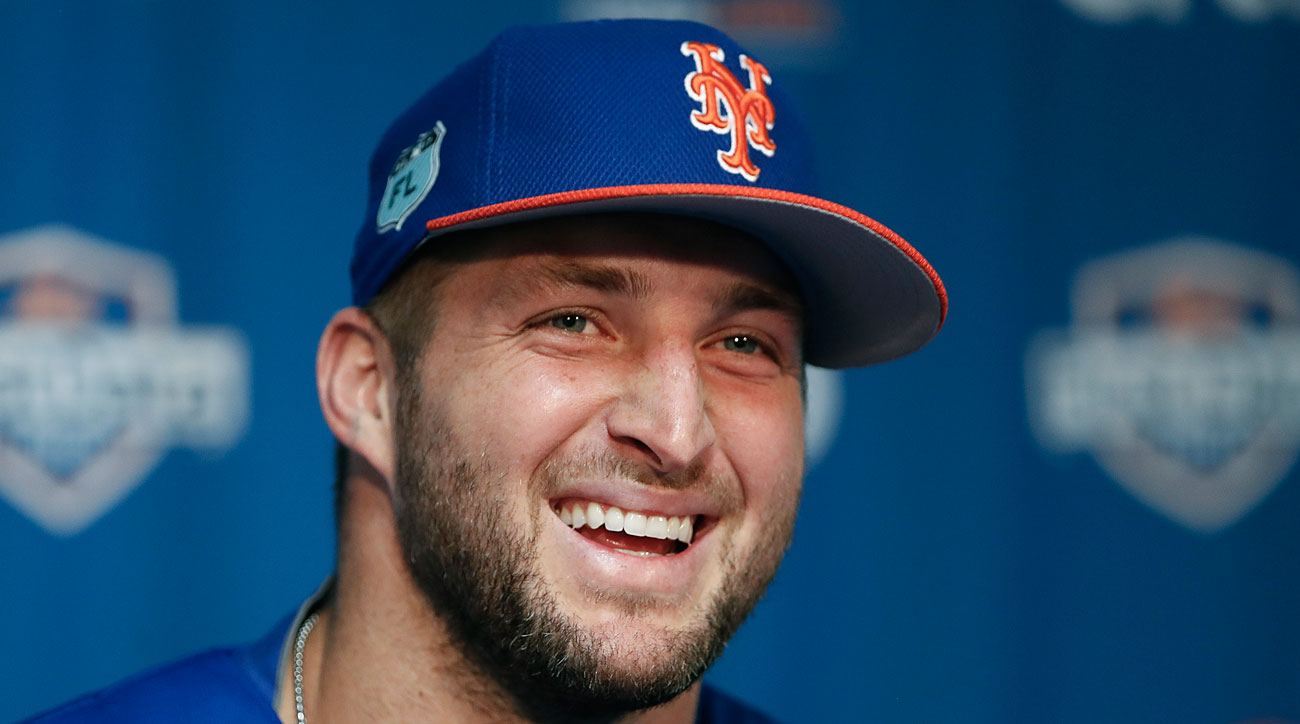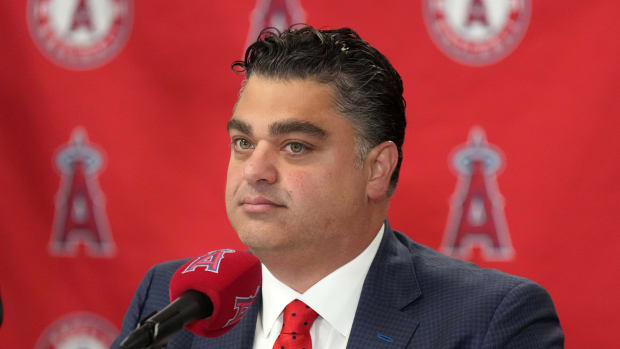Tim Tebow looks predictably overmatched in hype-filled spring debut for Mets
Former Heisman Trophy winner Tim Tebow made his Grapefruit League debut for the Mets on Wednesday and drew a standing ovation—for grounding into a double play, albeit one that scored the tying run. Serving as the designated hitter for New York split squad game against the Red Sox in Port St. Lucie, Tebow went 0-for-3 with a pair of strikeouts, put just one ball into play and was the lone Mets starter not to collect a base hit. He did reach base once, via a hit-by-pitch, but was then quickly doubled off on a line drive to second base. In all, it was an inauspicious but inconsequential debut, one that wouldn’t have been noticed at all if not for the hype surrounding the game.
Batting eighth in a lineup that featured six of New York's eight regular position players and started by ace Noah Syndergaard, the 29-year-old Tebow—a lefty swinger listed at 6'3", 255 pounds—faced four different Boston pitchers, all with major league experience. In the third inning, he stepped in against reigning AL Cy Young Award winner Rick Porcello, admittedly a tough draw. Tebow struck out on four pitches, all fastballs, swinging only at strike two, uppercutting while leaning on his back foot. Strike three was a quality pitch, a knee-high fastball on the outside corner of the plate; after being rung up, Tebow turned to home plate umpire Ryan Additon in disbelief and grimaced. Welcome to the big leagues, sort of.
In the fourth inning, with the bases loaded and nobody out against 27-year-old righty Noe Ramirez—a fringe reliever with 31 major league appearances and a 5.19 ERA with Boston the past two seasons combined—Tebow hit a loud foul ball and a lesser one, then on a 1-2 pitch, grounded into a routine 4-6-3 double play that scored Lucas Duda; it was then that he drew his ovation.
In the sixth, with runners at the corners and nobody out against 26-year-old lefty Brian Johnson—a well-regarded prospect whose 2016 was wrecked by injuries—he bailed on a curveball but reached base when a fastball glanced off his right shoulder. Tebow, however, then got caught too far off base when L.J. Mazzilli (the son of former Mets star Lee Mazzilli) lined out to second baseman Deven Marrero. In the eighth, with the bases empty against 28-year-old righty Brandon Workman, who last pitched in the majors in 2014, Tebow struck out looking at three pitches—a fastball, a slider on the inside corner and a curve on the outside edge. Particularly in the last plate appearance, he wasn’t shy about questioning Additon’s strike zone. The Boston Herald’s Mike Silverman tweeted that Tebow stared at the ump four times on the day.
Connecting with a grand total of three pitches, lawyering the strike zone and making a mental mistake on the bases, Tebow looked like a player in over his head—just as all of the evidence coming into the game suggested he was. If it were anyone else doing so in a March 8 exhibition, it wouldn’t merit notice except in the notebooks of the Mets' coaches and front office brass. New York has invited this scrutiny, however, by putting a famous but over-aged and underqualified player in this position, even if it comes at a time when the squad has been left short-handed by split squad games and the concurrent World Baseball Classic.
Picking the most interesting spring training NRIs, from prospects to suspects
Tebow starred as a quarterback at the University of Florida, winning the Heisman Trophy as a sophomore in 2007, leading the team to the BCS championship in '08 and earning all First Team All-SEC honors three times; he was also a Heisman finalist in 2008 and '09, and after the latter season was named Sports Illustrated's College Football Player of the Decade. His three-year NFL career (2010 to '12) met with only limited success, however. Drafted in the first round by the Denver Broncos in 2010, he engineered some dramatic come-from-behind victories that helped the team to a playoff berth, but he completed less than 50% of his passes, lost his job in Denver and played sparingly with the New York Jets in in 2012. After they released him, subsequent attempts to catch on with the New England Patriots ('13) and Philadelphia Eagles ('15) fell short. He remained in the public eye via his job as a college broadcaster and his charitable works, with sports talk shows endlessly speculating about his next move independent of industry assessments of his talent.
With his football dreams thwarted, Tebow decided to pursue baseball despite having not played since his junior year (2005) at Nease High School in Ponte Vedra Beach, Fla. His fame and raw athleticism was enough to draw 46 scouts from 28 of the 30 teams to a showcase in late August 2016. The Mets signed him to a minor league contract with a $100,000 bonus in September—less than the slot value of a 10th-round draft choice but far more than many of Tebow’s future minor league teammates received. From the start, the deal drew criticism as a publicity stunt, centered more around jersey and ticket sales than Tebow’s level of talent. Not only do his age and inexperience make success unlikely, but his plan to miss weekends during his Arizona Fall League stint to continue working as a college football broadcaster raised further questions about his level of commitment.
Over/under: Which MLB teams will beat or fall short of their 2017 expectations?
Tebow homered in his first plate appearance in the instructional league, but he struggled in the AFL, which features many of the game's top upper-level prospects. Playing in 19 of the Scottsdale Scorpions' 32 games, he was overmatched at the plate, hitting .194/.296/.242 with three doubles, eight walks and 20 strikeouts in 62 plate appearances. He missed almost a week due to a right knee injury suffered while unsuccessfully attempting a stolen base (he went 1-for-3 in that department). Midway through the AFL season, ESPN's prospect expert, Keith Law, filed a blistering scouting report: "His presence here is a farce, and he looks like an imposter pretending to have talent he does not possess… His swing is long, and he wields the bat like someone who hasn't played the sport in more than a decade, which he hasn't. He can't catch up to 90 mph, which is well below the major league average for a fastball.. in left field, his routes look like those of a wide receiver."
An anonymous AL scout was similarly blunt in his assessment, telling Kristie Ackert of the New York Daily News, "Plus raw power, but too much length to swing. Poor pitch recognition. Must shorten swing or he won’t hit anything above 90 [mph] . . . . He’s below average outfielder. He runs bad routes, has slow jumps and well below average arm strength . . . zero feel for the game.”
Even so, the Mets have remained committed and supportive, with Scorpions manager Tom Goodwin pointing to Tebow's improved pitch recognition over the course of the short season and general manager Sandy Alderson conceding, "The guy is going through kind of a warp-speed development process." Tebow spent part of the off-season working in Arizona with Mets hitting coach Kevin Long, who praised his work ethic, and worked out with former Met Daniel Murphy, his neighbor in Jacksonville, Fla., as well. Though he was not officially invited to New York's major league camp, he reported early to Port St. Lucie for their STEP program, generally for the team's top prospects.
The organization's heavy participation in the World Baseball Classic—they've sent more players from their 40-man roster (nine) than any other team—created an acute need for warm bodies, particularly with split-squad games scheduled for March 8 and 10, and so the Mets planned for Tebow to get this look in Grapefruit League action. Whether it’s for an earnest gauge of his current capability or merely a cynical chance to capitalize on the publicity build-up is something of a Rorschach blot. For what it's worth, the game at Port St. Lucie did not sell out. New York manager Terry Collins said afterward that Tebow would start again on Friday, and this time play the outfield.
Where MLB stars are playing in WBC, and who fans of each MLB team should root for
While there’s no begrudging Tebow’s pursuit of his (secondary) dream, the beef here is mainly that he’s getting opportunities based on his fame rather than his talent level. Surely the Mets have upper minor league prospects who have spent years suffering the indignities of minor league life while working to make four plate appearances in front of manager Terry Collins and against Porcello and company. Then again, the Mets gave more than 20 plate appearances to country singer Garth Brooks in spring training 2000 (he went 0-for-17 with four walks), and that was after Brooks went 1-for-22 with the Padres the year before. Some teams aren’t above putting in an anti-ringer if it will sell tickets in March, but is the calculus the same in July when Tebow will be playing some level of A-ball at the expense of a kid 10 years younger?
One of the great things about baseball is that nobody can hide for too long. Tebow will get a few swings in during spring training, and the Mets will sell a few jerseys. But eventually, he’ll be in real competition, and he’ll either prove his mettle against pitchers when the adrenaline is flowing, or he’ll live up to a favorite line about an obscure former prospect from The Great American Baseball Card Flipping, Trading, and Bubble Gum Book: “Dear Ma, I’ll probably be home sometime next week. They’re starting to throw me the curve ball.”



































